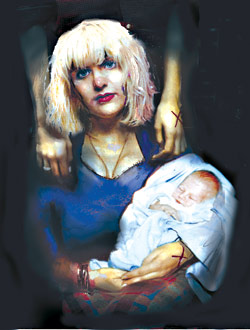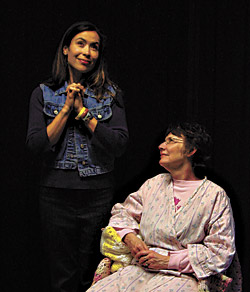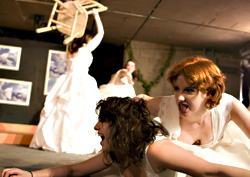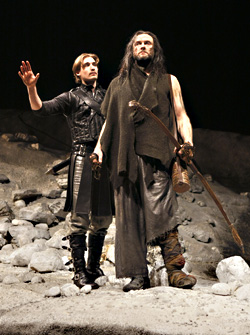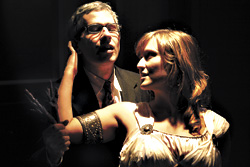Some folks have family meetings to air their grievances. In Courtney Love’s go-nuclear family, they write books instead, or communicate via courtrooms. Courtney has mouthed off about her parents for decades. Having kept mum for years, Courtney’s mom, Linda Carroll, an Oregon therapist, just published Her Mother’s Daughter: A Memoir of the Mother I Never Knew and of My Daughter, Courtney Love (Doubleday, $24.95).
In November, Courtney publishes Dirty Blonde: The Diaries of Courtney Love, the lead fall title for prestigious Farrar Straus Giroux’s Faber imprint. “It’s not intended as any kind of reply to her mother’s book,” says her editor, Denise Oswald. “It is similar to [Kurt Cobain’s] diary in that it will be comprised in part of direct reproductions of her diary pages . . . a bricolage, to borrow from the avant-gardists to whom Courtney is certainly an heir, of original diary entries that span from her childhood to the present day alongside a startling array of personal artifacts.” Expect snapshots, couture photography, correspondence, juvenile justice records, medical forms, and original artwork.
And Hank Harrison, Linda’s estranged first husband and Courtney’s estranged bio dad, plans to publish his retort, tentatively titled Love Kills: The Assassination of Kurt Cobain (Arkives Press), in Dirty Blonde‘s publicity slipstream. “I will prevail in this debate,” Hank insists, promising to deliver his not widely shared views on Cobain’s death, a counterbalance to Linda’s “maudlin diatribe,” the identity of Linda’s actual father, plus “dozens of pictures never before seen by anybody.”
But the family’s penchant for squabbling in print predates the Oprah Book Club era. Courtney’s National Book Award–winning grandmother, Paula Fox, wrote a series of novels and memoirs (Borrowed Finery) detailing her own tormented relationship with her mother. Linda calls this written history, now spanning at least four generations, “the curse of the firstborn daughters.” It’s an epic tale of maternal concern alternating with neglect, mad antics, destructive creativity, and decades of estrangements as cold as liquid nitrogen. Though it’s jaw-dropping gossip, it’s more than that. Courtney’s warlike tribe has cut a vast swath across our culture, and her legacy raises profound questions about personal identity in the face of fate.
How did this one clan, so literary, become so dysfunctional? And will the curse extend to the fifth “first daughter,” Kurt Cobain’s Love child, Frances Bean Cobain? Linda, in extensive and exclusive interviews granted to Seattle Weekly, reveals the deep roots of Courtney’s outrageous public behavior and speculates on the future of the Fox/Carroll/Love/Cobain family.
The story begins with Elsie Fox; she was Linda’s grandmother and Courtney’s great-grandmother (see family tree), though neither one knew she existed until 13 years ago. Turns out Elsie was Courtney’s intellectual wild-child doppelgänger. She partied hard with her husband, Paul Fox, and his cousin Douglas Fairbanks, and wrote screenplays so godawful that Graham Greene called one, Last Train From Madrid, “the worst movie I ever saw.”
“They were wild,” says Linda. “I think what’s fascinating is that Courtney has this showbiz life inside her that emerged with no knowledge that it was in her background.” Seven decades before Courtney grabbed Quentin Tarantino’s Oscar for Pulp Fiction at a wild Hollywood party, Elsie was hitting the fast lane with Fairbanks, the Australopithecus of Hollywood party animals. “Humphrey Bogart once threw my grandmother in a lake,” says Linda. Why? “My grandmother was quite awful.” Was she simply outspoken, ahead of her times? “No, she wasn’t. She was really mean.”
Linda recently looked up Elsie, a nonagenarian in Nantucket. “She answered the door and said, ‘Are you a Jehovah’s Witness?’ I said, ‘No, actually I’m your granddaughter.’ She was really remarkable, really fun. She was very estranged from my mother. She was very gracious, but she wasn’t warm. She was very cold.”
This opinion is shared by Elsie’s daughter, Paula Fox (Linda’s mother). According to Paula, Elsie meant to abort Paula but didn’t notice she was pregnant in time, and so dumped her in a foundling home in New York. Passed like a bad penny among friends and relatives, Paula was taken in by a kindly minister. When she finally met mama Elsie at age 5, Paula recalled, “I sensed that if she could have hidden the act, she would have killed me.” Instead, Elsie snatched her away for a chaotically itinerant life roaming Manhattan, Florida, Cuba, New Hampshire, and Hollywood.
When Paula was grown, she and Elsie became so estranged that they did not see each other for about 40 years. Paula got even in a series of memoirs and autobiographical novels that Jonathan Franzen ranks higher than Roth, Bellow, and Updike. What’s fascinating is the way traits and accusations reverberate down the generations of the Cursed Firstborns. Paula says Elsie flung a glass at her daughter’s head—an act echoed decades later when Courtney famously flung items including a glass, a flashlight, a booze bottle, and a microphone stand at people who peeved her. Paula flung herself into books and a bit of Hollywood work. After a bad, brief teenage marriage to a member of Orson Welles’ Mercury Theatre, she found herself traumatized, penniless—and pregnant. She put Linda up for adoption. Forty-nine years later, when they first met, Paula explained to Linda that she’d given her up because “I thought that you were me, and I was my own mother. I thought that by releasing you at birth, I would ensure you would not have to go through the pain and bewilderment that I went through.” Remorseful, Paula has said she tried to reverse the adoption 10 days later, but that doctors refused her any information about Linda’s whereabouts. “I think they’d gotten money to place her,” Paula told The Guardian of London.
“I was chaotic, disorganized, married badly, but my kids were deeply loved, our lives were always full of rich community, great people, wonderful adventures.” —Linda Carroll
So Linda grew up in pain and bewilderment as the adopted daughter of San Francisco’s Jack and Louella Risi, whom she describes as a generous but rather cold, unartistic, repressively Catholic, quarrelsome couple who buried the truth about Linda’s parentage. Alcoholic Jack sexually molested her, and Louella habitually introduced her as “my adopted daughter.” Linda fled into fantasies about her true mother. She would sit on the curb outside her house trying to pick out her birth mother from the passersby on their way to the streetcar. “I had all kinds of stories about who she was.” She narrowed it down to one commuter she named Ginger, a glamorous beauty, and the Drunk Lady. “I always had the two polarities in my mind: Is she a queen, or is she a witch?” When Ginger smiled at her, Linda told friends her real mother had contacted her and was going to take her away. “My adopted mother was just irate, and said, ‘Your real mother was not Ginger, she was a bad woman.’ And then I pushed the whole thing away.”
Unfortunately, Linda did not push away a suitor named Hank Harrison, a pal of Grateful Dead star-to-be Phil Lesh. After a short courtship involving tripping on LSD with Jerry Garcia as a pinwheel-eyed chauffeur, in 1964 Linda and Hank had Courtney Michelle Harrison, Linda’s first known living relative. “Michelle means ‘She who is like God,'” says Linda. “I loved that.” Poppy Z. Brite’s bio, Courtney Love: The Real Story, influenced by Courtney, claims that her birth certificate reads, “Love Michelle Harrison,” and shaves a year off her age. Both Linda and Hank call this nonsense. Linda implies that she may have inspired the stage name by playfully addressing her young daughter, Brit-style, as “Courtney, love.” Hank says Courtney herself coined it years later as her stripper name. “She was topless dancing in Portland. She was underage, so she changed her name.” Perhaps she wished to rewrite the past and take from her parents the right to name herself, to reinvent herself—to be, creatively speaking, like God.
Linda and Hank soon split. “I wasn’t a nice guy,” says Hank. Linda married an ambitious trash handler, Frank Rodriguez, whom her friends called “the Garbage Adonis.” In 1969, they moved to Eugene to finish school (and escape Hank). They had Courtney’s half-sister Nicole, who flourished. The marriage failed, and so did the next, to a man she identifies only as Mark, but Linda at last found happiness with Tim Barraud, for 17 years so far. “I had no sense of who I was,” says Linda. “How could I select a mate that was right for me? It’s amazing to marry three times and get it wrong, and finally get it right at 45. Isn’t it interesting I do marriage counseling—I know so much about what doesn’t work!”
Linda’s adoptive parents unexpectedly left her a generous inheritance—not millions, but enough to move her proliferating brood into a white colonial mansion on the Mohawk River in Marcola, Ore. “I was chaotic, disorganized, married badly, but my kids were deeply loved, our lives were always full of rich community, great people, wonderful adventures,” says Linda. Courtney’s younger siblings, Nicole, Jaimee, Tobias, and Daniel, apparently prospered—becoming a therapist, a lawyer, an English prof, and a writer—and Tim’s kids have done art direction and props work for The Lord of the Rings, Pride and Prejudice, and Robert Altman’s upcoming A Prairie Home Companion.
But Courtney, who was to outearn them all put together, did not do well. “Her childhood was horrible,” Linda says. “It was tragic. I couldn’t protect her from any of what happened to her, the worst being inside her own head. And that’s what as a mother we want to be able to do for our kids.”
One factor may have been the chaos the other kids surfed with greater emotional success. In a fit of back-to-the-land idealism, Linda impulsively moved to New Zealand in 1973, distancing Courtney from her main father figure, Frank, in Oregon. Linda saw an ad for a Summerhill-like Kiwi free school in The Whole Earth Catalog, moved there, and took up sheep farming, at which she proved less than skillful (she set a hillside on fire by mistake).
Courtney loathed the idea of New Zealand, and wound up shuttling between there and Oregon—including, after protracted acting out, the Hillcrest Youth Correctional Facility in Salem and Eugene’s Looking Glass Shelter. Not knowing about her mother’s past, Linda couldn’t see how eerily the peripatetic disruptiveness echoed that of Elsie and Paula’s looking-glass life. When Linda emancipated Courtney at 16 and gave her a slice of the inheritance, Courtney began burning it up on a great-grandma-echoing rampage through Japan, Ireland, England, San Francisco, L.A., Taiwan, New York, Minneapolis, Spain, and Alaska, in a successful quest for fame, fortune, sex, love, and violent artistic expression.
For decades, Linda suffered nightmares about demons at Disneyland’s Haunted House hunting down helpless children whom she could not protect. And yet Linda insists that Courtney’s problems were not essentially caused by the lifestyle that, after all, didn’t seem to hurt the other kids.
“I’m sort of ’60s free-spirited and let-your-kids-be-who-they-are. But if your kid sets fires, what do you do?” Courtney has been accused of starting many literal fires, including the angry incineration of her mom’s precious holy cards from her Catholic girlhood. Linda says Courtney torched them to avenge being chided for falsely convincing little Nicole that she was a retarded, adopted child, and not really Linda’s daughter.
Linda’s response to the conflagration was to try to stay cool and not burst into flames herself. Courtney thinks Linda is cold—shades of Elsie! “She’s right about my coldness, but it’s not coldness,” says Linda. “It’s like when she calls you screaming and crying, so I would immediately go into this: ‘OK, what do you need, Courtney? OK, I’ll listen’—but I couldn’t be engaged to her from my emotions, ’cause I couldn’t survive it.”
Linda swears she did her best to care for her budding queen of noise. As a young girl, Courtney seemed out of control, plagued by fits of screaming, strange fears, bizarre nightmares, grueling loneliness. School was a waking nightmare—except for the day Courtney blissfully said she’d found her first friend in first grade, a little Swedish girl. “It was a pinnacle moment,” says Linda. “Every day she’d describe the food and Ingrid’s clothes—I mean, an incredible descriptive capacity.” But abruptly, Ingrid turned against Courtney, turned evil. “I said, ‘Do you want me to go talk to the teacher, honey?’ And she said, ‘Yes, please, Mommy, talk to the teacher; find out why the Swedish girl hates me.’
“The teacher said, ‘I’m really sorry to tell you this, but there is no Swedish girl.'” They’d done a brief lesson about Sweden. “The part of that story that’s so extraordinary to me is that Courtney was really glad that I was going to go,” says Linda. “If she knew she was lying, she’d say, ‘Oh, no, Mommy, don’t talk to the teacher.’ But it was like she believed the story.” Hank, who has no contact with Linda or Courtney, says of his kid: “She’s living in a fantasy world.”
Kurt and Courtney never talked about emotions, which puzzled Linda. It was a constant Trivial Pursuit game featuring pop-punk arcana. “They were like encyclopedias,” she says.
But Cobain was Courtney’s fantasy come true—like the Swedish girl, only real, a soul mate. “Destructive as I felt that relationship was in some ways, I also saw something very chargey and sweet,” says Linda, “something sweet in her which I hadn’t seen since she was a kid. Like this high energy going back and forth, and they were verbally, verbally charged.” Kurt and Courtney never talked about emotions, which puzzled Linda—it was a constant Trivial Pursuit game featuring pop-punk arcana. “They were like encyclopedias,” she says.
It is possible that some of Courtney’s and Linda’s disparate memories are each true to the way they saw their star-crossed fate. For instance, Courtney has bitterly spoken of the “chicken coop” Linda forced her to live in behind the family home in New Zealand. In Linda’s book, there’s a photo of a 12-year-old Courtney proudly beaming in front of the building, a brand-new, handmade redwood cabin on the river, a far cry from the old chicken coop it replaced and close to the main family quarters. And yet, its reason for being was to isolate the Courtney problem from the rest of the family. “It took a long time, but I finally started to remove myself from her. It was, like, a calculated thing to protect the family, to protect myself. I didn’t know what to do with her. She would scream and throw things, and I had—the only thing that I could do was go into some kind of a detached place, which really wasn’t detached. It was like my heart was breaking over and over.”
There is another possible reason for Courtney’s version. Like Kurt, who falsely claimed to have lived as a teen under an Aberdeen bridge, Courtney was poetically rendering an aspect of her deepest experience, and attempting to replace her real life with a more meaningful and status- enhancing legend. “Courtney doesn’t know how to genuinely be,” says Linda, “and so she knows how to be from a place of acting, because I think she’s so fragile.”
Despite Courtney’s hair-trigger resentments, when in hot water, she has turned to Linda screaming for help—after Kurt’s disappearance and suicide, and earlier, when she infamously blabbed about her habits to Vanity Fair and got the authorities on her case. “She was crying, they’re gonna take away her baby,” recalls Linda. “I said, ‘Well, we won’t let them take her away.'” Courtney’s younger sisters, Jaimee and Nicole, were willing to pitch in to help look after Kurt and Courtney’s daughter, Frances, in a pinch, putting their own lives on hold.
“May I give my perspective?” Tim Barraud asks Linda. “Every time she connected with you, which was usually around a crisis, it would often lead to connection and something genuine and warm, etc. And every time, you’d get sucked into that, and every time you’d get smashed.” This has happened since she was a toddler, says Linda: “Courtney’s no different now than when she was 2 years old, just in a bigger body.”
Her own family saga has convinced Linda that the ’60s-style psychological idea of the tabula rasa with unlimited human potential unlockable by the right enlightened environment is hooey. “Everything was nurture and conditioning,” she says. “Now we’re finding that more and more is hardwiring. We get made better or worse, but we don’t get made.” Hank vows to sue Courtney if her book claims he gave her drugs as a toddler. He thinks her adult problems may be traceable to the alcoholism of both his father and Elsie’s husband, Paul Fox, Courtney’s maternal great-grandfather.
Linda might have lived forever existentially cut off from her heritage had she not been jolted by the birth of Courtney and Kurt’s daughter, Frances Bean Cobain, in 1992. “When I saw Frances, when she was born, I thought, ‘I have to find my mother,'” says Linda. For $400, a private investigator in Reno found Paula, the author of Desperate Characters (made into a 1970 Shirley MacLaine flick) and award-winning children’s books. Hank thinks Paula’s books are “kinda scary for kids.” Paula’s The Slave Dancer is a controversially frank children’s book about a kidnapped child who plays a fife aboard a slave ship to make the slaves dance, to keep them in shape for the auction. This reminds me of a dream Courtney had in childhood wherein she started a farm for women where she would beat them and make them beautiful. “The darkness is there, dude,” says Hank. Paula’s 1976 novel, The Widow’s Children, was inspired by Elsie’s cold refusal to inform Paula of the death of her beloved grandmother (Elsie’s kindly mother). Like Courtney’s stunningly superb concerts and award-winning movie work, the darkness is what makes the books great.
But the birth of Frances may have broken the Curse of the Firstborn Daughters. Paula is close with her grandkids (especially the writer), and her daughter—despite being from different worlds. “We got into terrible arguments about the ’60s,” says Linda. “She hated the ’60s.” Paula disliked meeting the vulgar Courtney, but bonded with the other grandkids.
The big question now involves Frances Bean Cobain. “Courtney won’t let Linda or me see the granddaughter,” says Hank. Considering how Linda helped Courtney during the Frances custody crises, it would be ironic if Courtney kept her child away from Linda forever. But in our many conversations at her Oregon Coast cabin and by phone and e-mail, Linda’s tone is never vindictive, and her book is not a retaliatory tell-all. “If I were going to do that, I would’ve gotten into the celebrity craziness on Jerry Springer.” She insists she will never give up on loving her trouble- magnet child. “I just want her to be OK,” Linda says of Courtney, her voice softly quavering. “And I don’t—I don’t think she is.”
Linda wrote her book for Frances, while facing a photo of the 13-year-old heiress to money and sorrow. “I felt like it’s something I could really leave to my granddaughter. What she’s read about her parents—so much of it is so crazy, or it’s not true.
“Frances is very much her own person,” says Linda. “I recognize myself and Courtney in her in some ways; she is intense, funny, perceptive, and does 12 things at once.” Frances also shares the intense empathy Courtney felt for animals as a child— minus the mercurial flashes of cruelty. When Frances recently visited Tim Barraud’s veterinary clinic, “Tim said he had never seen a child who was able to sit with such patience. She held sick animals in their cages [and] never lost interest or stopped trying to help.”
When Frances was about 3, Linda bought them each a set of nesting Russian dolls. Frances took them all apart, then said, “I have an idea, Grandma. Why don’t you take my tiniest one and put it in your doll, and I’ll take your tiniest one and put it in mine. Then we will always have a part of each other with us.”
“Of course, she will have challenges,” says Linda. “Not just the loss of her father and how public her mother’s troubles have been, but the addition of celebrity and privilege can really complicate things for anyone. Still, I think she has a very solid core; she is very close to Kurt’s mother and sisters, she has had great relationships with my other daughters and her cousins (their children), and she has a remarkable ability to make and keep friends.
“During times of Courtney’s troubles, I blamed myself for them,” says Linda. “And when I looked at the solid lives my other kids made, I thought, ‘How did that happen?’ It’s almost as though we each have a unique lens through which we look at the world. As a therapist, I see people who have come from the most traumatic home lives and are able to make good solid choices for love and work; others are still traumatized at 35 about the time their father yelled at them or their mother threw a cushion.” Linda’s most famous client, ex–Weather Underground fugitive Katherine Power, managed, with Linda’s help, to come out of the cold after 23 years on the FBI’s most-wanted list. Perhaps Frances will survive her mom’s reign on the worst-behaved list. “I think Frances’ lens will give her an ability to make a lot of good choices and learn from the ones that aren’t so good.”
Frances comes of age amid a welter of words that tell her family’s story. But what story will Frances tell about herself? Will she write the concluding chapter to the epic Curse of the Firstborn Daughters? All we have to go on is a mini-interview in Teen Vogue: “I don’t want to be titled as Courtney Love and Kurt Cobain’s daughter. I want to be thought of as Frances Cobain.” But her forebears leave her a paradoxical legacy—example after example of heroic self-definition against all odds and equal evidence that character is fate, as ineluctable as Greek tragedy. As Mark Twain put it, “History doesn’t repeat itself, but it does rhyme.” Linda thinks Frances will turn out fine because of the sturdy character she’s already evinced. As Linda says, perhaps unconsciously echoing Kurt Cobain, “I really think we come as we are.”

